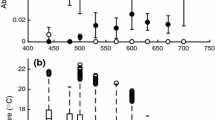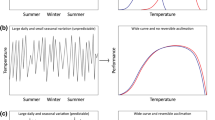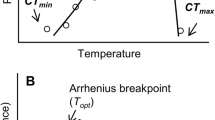Abstract
Thermal performance curves (TPCs) represent an increasingly popular tool in ecology for anticipating species responses to climate change. TPC theory has been developed using species that experience similar temperatures during activity and at rest and consequently exhibit thermal ranges for activity that closely coincide with their physiological thermal tolerances. Many species, however, experience other stressors, such as desiccation, that limit active behaviour at temperatures below the maximum values experienced. As a result, activity is constrained to a narrow thermal window that is a subset of the range of temperatures that can be tolerated physiologically. This results in a decoupling of behavioural and physiological TPCs that does not conform to the present paradigm. To test the generality of TPC theory, we measured thermal responses for behaviour (crawling speed) and physiological tolerance (heart rate) for six rocky shore gastropods spanning a thermal/desiccation stress gradient. We hypothesized a positive relationship between shore level and the degree of decoupling of behavioural and physiological TPCs. This prediction was confirmed, and was explained by the extension of the physiological TPC beyond the range of the behavioural TPC. Decoupling of behavioural and physiological TPCs is central to predicting accurately the fitness dynamics of ectothermic species subject to multiple stressors. We believe that this decoupling should be explicitly considered as an adaptive trait defining an organism’s thermal niche.





Similar content being viewed by others
References
Adolph SC, Porter WP (1993) Temperature, activity, and lizard life histories. Am Nat 142:273–295
Angilletta MJ (2009) Thermal adaptation: a theoretical and empirical synthesis. Oxford University Press, New York
Barnhart MC, McMahon BR (1987) Discontinuous carbon dioxide release and metabolic depression in dormant land snails. J Exp Biol 128:123–138
Branch GM, Borchers P, Brown CR, Donnelly D (1988) Temperature and food as factors influencing oxygen consumption of intertidal organisms, particularly limpets. Am Zool 28:137–146
Brett JR (1971) Energetic responses of salmon to temperature. Study of some thermal relations in physiology and freshwater ecology of sockeye salmon (Oncorhynchus nerka). Am Zool 11:99–113
Cerdá X, Retana J, Cros S (1998) Critical thermal limits in Mediterranean ant species: trade-off between mortality risk and foraging performance. Funct Ecol 12:45–55
Clark TD, Sandblom E, Jutfelt F (2013) Aerobic scope measurements of fishes in an era of climate change: respirometry, relevance and recommendations. J Exp Biol 216:2771–2782
Denny M, Helmuth B (2009) Confronting the physiological bottleneck: a challenge from ecomechanics. Integr Comp Biol 49:197–201
Deutsch CA et al (2008) Impacts of climate warming on terrestrial ectotherms across latitude. Proc Natl Acad Sci 105:6668–6672
DeVries ZC, Kells SA, Appel AG (2016) Estimating the critical thermal maximum (CTmax) of bed bugs, Cimex lectularius: comparing thermolimit respirometry with traditional visual methods. Comp Biochem Physiol A: Mol Integr Physiol 197:52–57
Dillon ME, Wang G, Huey RB (2010) Global metabolic impacts of recent climate warming. Nature 467:704–706
Farrell AP (2009) Environment, antecedents and climate change: lessons from the study of temperature physiology and river migration of salmonids. J Exp Biol 212:3771–3780
Frederich M, Pörtner HO (2000) Oxygen limitation of thermal tolerance defined by cardiac and ventilatory performance in spider crab, Maja squinado. Am J Physiol Regulatory Integrative Comp Physiol 279:R1531–R1538
Fry FEJ (1947) Effects of the environment on animal activity. Publ Ontario Fisheries Res Lab 55:1–62
Fry FEJ (1971) The Effect of environmental factors on the physiology of fish. In: Hoar WS, Randall DJ (eds) Fish physiology, vol VI. Academic Press, New York, pp 1–98
Garrity SD (1984) Some adaptations of gastropods to physical stress on a tropical rocky shore. Ecology 65:559–574
Gilchrist GW (1995) Specialists and generalists in changing environments. I. Fitness landscapes of thermal sensitivity. Am Nat 146:252–270
Gunderson AR, Armstrong EJ, Stillman JH (2016) Multiple stressors in a changing world: the need for an improved perspective on physiological responses to the dynamic marine environment. Annu Rev Mar Sci 8:357–378
Helmuth B et al (2010) Organismal climatology: analyzing environmental variability at scales relevant to physiological stress. J Exp Biol 213:995–1003
Hernández RM, Bückle RLF (2002) Temperature tolerance polygon of Poecilia sphenops Valenciennes (Pisces: poeciliidae). J Therm Biol 27:1–5
Hochachka PW, Somero GN (2002) Biochemical adaptation: mechanism and process in physiological evolution. Oxford University Press, New York
Huey RB, Kingsolver JG (1989) Evolution of thermal sensitivity of ectotherm performance. Trends Ecol Evol 4:131–135
Huey RB, Stevenson RD (1979) Integrating thermal physiology and ecology of ectotherms: a discussion of approaches. Am Zool 19:357–366
Huey RB, Peterson CR, Arnold SJ, Porter WP (1989) Hot rocks and not-so-hot rocks: retreat-site selection by garter snakes and its thermal consequences. Ecology 70:931–944
Huey RB, Kearney MR, Krockenberger A, Holtum JAM, Jess M, Williams SE (2012) Predicting organismal vulnerability to climate warming: roles of behaviour, physiology and adaptation. Philos Trans R Soc B Biol Sci 367:1665–1679
Iacarella JC, Helmuth B (2012) Body temperature and desiccation constrain the activity of Littoraria irrorata within the Spartina alterniflora canopy. J Therm Biol 37:15–22
Jobling M (1981) Temperature tolerance and the final preferendum—rapid methods for the assessment of optimum growth temperatures. J Fish Biol 19:439–455
Kearney M, Porter W (2009) Mechanistic niche modelling: combining physiological and spatial data to predict species’ ranges. Ecol Lett 12:334–350
Klok CJ, Sinclair BJ, Chown SL (2004) Upper thermal tolerance and oxygen limitation in terrestrial arthropods. J Exp Biol 207:2361–2370
Kovac H, Käfer H, Stabentheiner A, Costa C (2014) Metabolism and upper thermal limits of Apis mellifera carnica and A. m. ligustica. Apidologie 45:664–677
Lighton JRB, Turner RJ (2004) Thermolimit respirometry: an objective assessment of critical thermal maxima in two sympatric desert harvester ants, Pogonomyrmex rugosus and P. californicus. J Exp Biol 207:1903–1913
Lima FP, Wethey DS (2009) Robolimpets: measuring intertidal body temperatures using biomimetic loggers. Limnol Oceanogr Methods 7:347–353
Lutterschmidt WI, Hutchison VH (1997) The critical thermal maximum: history and critique. Can J Zool 75:1561–1574
Magnuson JJ, Crowder LB, Patricia AM (1979) Temperature as an ecological resource. Am Zool 19:331–343
Marshall DJ, Chua T (2012) Boundary layer convective heating and thermoregulatory behaviour during aerial exposure in the rocky eulittoral fringe snail Echinolittorina malaccana. J Exp Mar Biol Ecol 430–431:25–31
Marshall DJ, Dong YW, McQuaid CD, Williams GA (2011) Thermal adaptation in the intertidal snail Echinolittorina malaccana contradicts current theory by revealing the crucial roles of resting metabolism. J Exp Biol 214:3649–3657
Marshall DJ, Baharuddin N, McQuaid CD (2013) Behaviour moderates climate warming vulnerability in high-rocky-shore snails: interactions of habitat use, energy consumption and environmental temperature. Mar Biol 160:2525–2530
Marshall DJ, Rezende EL, Baharuddin N, Choi F, Helmuth B (2015) Thermal tolerance and climate warming sensitivity in tropical snails. Ecol Evol 5:5905–5919
McClanahan LL, Ruibal R, Shoemaker VH (1983) Rate of cocoon formation and its physiological correlates in a ceratophryd frog. Physiol Zool 56:430–435
McMahon RF (1990) Thermal tolerance, evaporative water loss, air-water oxygen consumption and zonation of intertidal prosobranchs: a new synthesis. Hydrobiologia 193:241–260
McMahon R (2001) Acute thermal tolerance in intertidal gastropods relative to latitude, superfamily, zonation and habitat with special emphasis on the Littorinoidea. J Shellfish Res 20:459–467
McQuaid CD, Branch GM, Frost PGH (1979) Aestivation behaviour and thermal relations of the pulmonate Theba pisana in a semi-arid environment. J Therm Biol 4:47–55
Monaco CJ, Helmuth B (2011) Tipping points, thresholds and the keystone role of physiology in marine climate change research. Adv Mar Biol 60:124–154
Newell RC (1973) Factors affecting the respiration of intertidal invertebrates. Am Zool 13:513–528
Polgar G, Khang TF, Chua T, Marshall DJ (2015) Gross mismatch between thermal tolerances and environmental temperatures in a tropical freshwater snail: climate warming and evolutionary implications. J Therm Biol 47:99–108
Pörtner HO (2002) Climate variations and the physiological basis of temperature dependent biogeography: systemic to molecular hierarchy of thermal tolerance in animals. Comp Biochem Physiol A Integr Physiol 132:739–761
R Core Team (2016) R: a language and environment for statistical computing. R Foundation for Statistical Computing, Vienna, Austria
Pörtner H-O (2010) Oxygen- and capacity-limitation of thermal tolerance: a matrix for integrating climate-related stressor effects in marine ecosystems. J Exp Biol 213:881–893
Pörtner HO, Knust R (2007) Climate change affects marine fishes through the oxygen limitation of thermal tolerance. Science 315:95–97
Sartoris FJ, Bock C, Serendero I, Lannig G, Pörtner HO (2003) Temperature-dependent changes in energy metabolism, intracellular pH and blood oxygen tension in the Atlantic cod. J Fish Biol 62:1239–1253
Schulte PM, Healy TM, Fangue NA (2011) Thermal performance curves, phenotypic plasticity, and the time scales of temperature exposure. Integr Comp Biol 51:691–702
Sinclair BJ et al (2016) Can we predict ectotherm responses to climate change using thermal performance curves and body temperatures? Ecology Letters 19(11):1372–1385. doi:10.1111/ele.12686
Sokolova IM, Pörtner H-O (2003) Metabolic plasticity and critical temperatures for aerobic scope in a eurythermal marine invertebrate (Littorina saxatilis, Gastropoda: littorinidae) from different latitudes. J Exp Biol 206:195–207
Somero G (2002) Thermal physiology and vertical zonation of intertidal animals: optima, limits, and cost of living. Integr Comp Biol 42:780–789
Somero G (2005) Linking biogeography to physiology: evolutionary and acclimatory adjustments of thermal limits. Front Zool 2:1. doi:10.1186/1742-9994-2-1
Somero GN (2012) The physiology of global change: linking patterns to mechanisms. Annu Rev Mar Sci 4:39–61
Stevenson RD (1985) The relative importance of behavioral and physiological adjustments controlling body temperature in terrestrial ectotherms. Am Nat 126:362–386
Stevenson RD, Peterson CR, Tsuji JS (1985) The thermal dependence of locomotion, tongue flicking, digestion, and oxygen consumption in the wandering garter snake. Physiol Zool 58:46–57
Stillman JH (2002) Causes and consequences of thermal tolerance limits in rocky intertidal porcelain crabs, genus Petrolisthes. Integr Comp Biol 42:790–796
Stillman JH (2003) Acclimation capacity underlies susceptibility to climate change. Science 301:65
Stillman JH (2004) A comparative analysis of plasticity of thermal limits in porcelain crabs across latitudinal and intertidal zone clines. Int Congr Ser 1275:267–274
Stillman JH, Somero GN (1996) Adaptation to temperature stress and aerial exposure in congeneric species of intertidal porcelain crabs (genus Petrolisthes): correlation of physiology, biochemistry and morphology with vertical distribution. J Exp Biol 199:1845–1855
Storey KB, Storey JM (1990) Metabolic rate depression and biochemical adaptation in anaerobiosis, hibernation and estivation. Q Rev Biol 65:145–174
Sunday JM et al (2014) Thermal-safety margins and the necessity of thermoregulatory behavior across latitude and elevation. Proc Natl Acad Sci 111:5610–5615
Van Damme R, Bauwens D, Verheyen RF (1991) The thermal dependence of feeding behaviour, food consumption and gut-passage time in the lizard Lacerta vivipara jacquin. Funct Ecol 5:507–517
van Dijk PL, Tesch C, Hardewig I, Portner HO (1999) Physiological disturbances at critically high temperatures: a comparison between stenothermal antarctic and eurythermal temperate eelpouts (Zoarcidae). J Exp Biol 202:3611–3621
Vasseur DA et al. (2014) Increased temperature variation poses a greater risk to species than climate warming. Proceedings of the royal society B: biological sciences 281
Verberk WCEP et al (2016) Can respiratory physiology predict thermal niches? Ann N Y Acad Sci 1365:73–88
Williams GA, Morritt D (1995) Habitat partitioning and thermal tolerance in a tropical limpet, Cellana grata. Mar Ecol Prog Ser 124:89–103
Acknowledgements
We are grateful to Gianluca Polgar for suggestions and comments during the early stages of the manuscript. Majeedah Zailani provided CTmax data for E. vidua and L. undulata, and crawling speed data for E. vidua. The manuscript was further improved by comments provided by two anonymous reviewers. This work is based upon research supported by the South African Research Chairs Initiative of the Department of Science and Technology and the National Research Foundation. CJM is supported by a Rhodes University postdoctoral fellowship. DJM was funded through a Brunei Research Council Grant (UBD/GRS/S&T/16).
Author information
Authors and Affiliations
Contributions
DJM conceived the ideas; CJM and DJM designed methodology and collected the data; CJM analyzed the data. All authors contributed critically to the drafts and gave final approval for publication.
Corresponding author
Ethics declarations
Conflict of interest
The authors declare that they have no conflict of interest.
Additional information
Communicated by Donovan P. German.
Rights and permissions
About this article
Cite this article
Monaco, C.J., McQuaid, C.D. & Marshall, D.J. Decoupling of behavioural and physiological thermal performance curves in ectothermic animals: a critical adaptive trait. Oecologia 185, 583–593 (2017). https://doi.org/10.1007/s00442-017-3974-5
Received:
Accepted:
Published:
Issue Date:
DOI: https://doi.org/10.1007/s00442-017-3974-5




